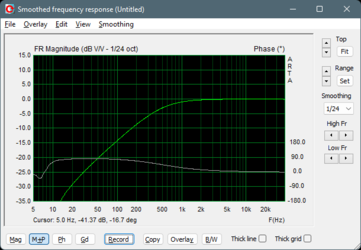One on the main purposes of "Use loopback as cal and timing reference" is possibility to provide protection for fragile DUTs with either passive (capacitor) or active high-pass filter in the signal path. Purpose of "loopback as cal..." option is to eliminate effect of high-pass filtering from the result. Reference input is connected to the output of high-passing stage/component so correct result is flat magnitude and phase if response of DUT is ideal flat.
For example,
active 1st order high-pass at 500 Hz in both measurement signal and loopback. HP filter is Xilica XP-4080 having some latency, but it does (should) not matter because "..as timing" option should remove latency of reference loop from the measurement.
ARTA, result is okay down to ~10 Hz:
REW ea25 with "Merge loopback..." option, result is wrong:
REW ea25 with "Make calibration..." option, result is wrong:
Comparison to
flat signal in reference loop. Measurement loop has 1st order HP at 500 Hz:
ARTA, result looks okay down to ~20 Hz:
REW ea25 with "Merge loopback..." option, result looks okay down to ~20 Hz:
Comparison to
flat signal in both inputs. Xilica DUT and Focusrite Scarlett 2i2 soundcard are not perfectly flat 5-40k, but "loopback as cal" should give flat result if channels are identical.
ARTA, result is exact down to 5 Hz:
REW ea25 with "Merge loopback..." option, result is not exactly flat:
"Make calibration..." gives the same result; not exactly flat.
Time windows in Preferences - Analysis were L=125 ms and R=500 ms in previous measurements. Window functions Tukey 0.25.
Program jams with 'Merge loopback...' option if time windows are (much) longer, for example L=500 ms and R=1000 ms.














